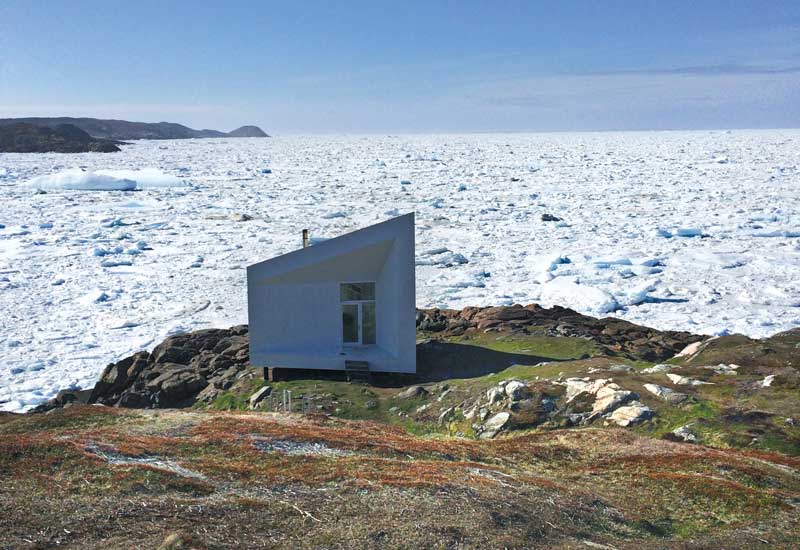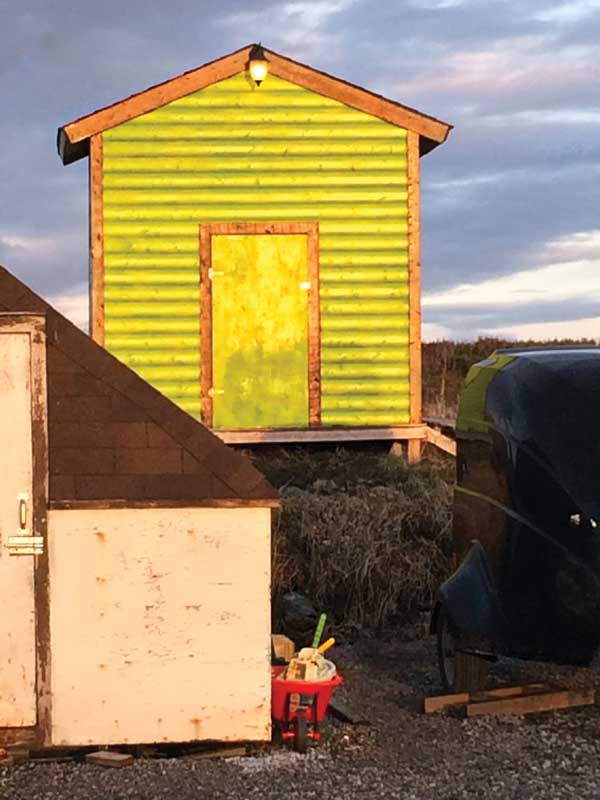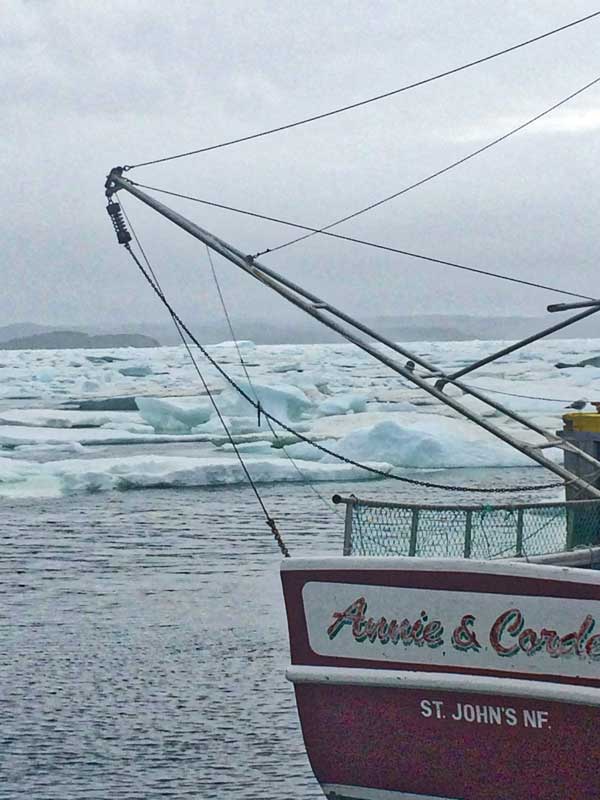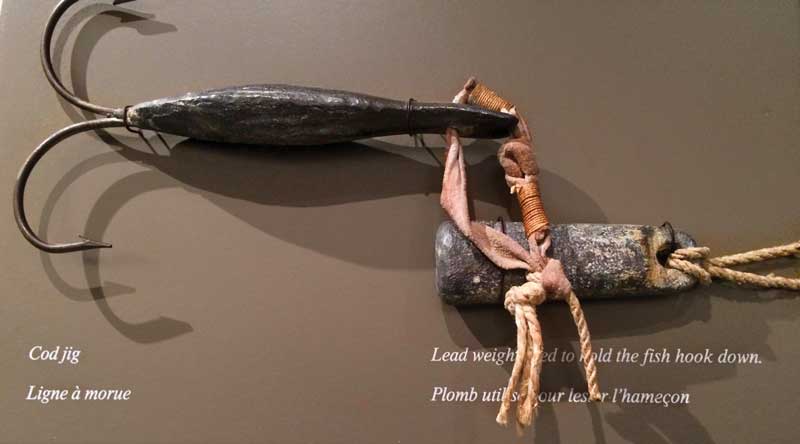All photos courtesy Nancy Harmon Jenkins
 In splendid isolation, Squish Studio, one of several provided by Fogo Island Arts for its artists-in-residence program, looks out across ice-packed Labrador Sea.
In splendid isolation, Squish Studio, one of several provided by Fogo Island Arts for its artists-in-residence program, looks out across ice-packed Labrador Sea.
I had made plans to go up to Newfoundland over and over and canceled them so many times that it became a joke among my friends. “Oh, I suppose any day now you’re off to NewfoundLAND,” they would say, giving it the preferred Canadian pronunciation. Well, she who laughs last, ha-ha, gets there in the end. Just before the summer solstice last year, I finally winged my way up to Deer Lake in the western part of the island, picked up a rental car and two friends who had also flown in, and headed up Route 430, the only road north.
We were bound for the Viking settlement, L’Anse aux Meadows (Lancie Meadows, we learned to say), six hours away at the top of the peninsula, looking out across the Labrador Sea. Rain sheeted across the coastal highway, windy gusts rocked our little rental car, and then the sun burst through scudding clouds and lit the wave tops. Newfoundland is the origin of “If you don’t like the weather, just wait a bit.” It’s a land of rocky barrens and shallow soils; scrub forests of conifers, bent and twisted against the wind; of muskeg, peat bogs and marshy ponds; low dunelands to the northwest, tumbled rocks and precipitous cliffs to the southeast, and vast unpopulated stretches of moor in between; spectacular vistas; and moose everywhere.
Icebergs ahead
The ice began to accumulate as we moved north and approached the Strait of Belle Isle, which separates Newfoundland from Labrador—huge blocks of pack ice that shifted like giant, alabaster-blue playing cards on the water’s surface. On the horizon we spotted the first icebergs—not the giants of picture postcards, more like what Newfoundlanders call “growlers” or, even smaller, “bergy bits.” Still, in June, with the pack ice an ominous presence, I can’t stop thinking about those Vikings setting sail in their open boats across the Labrador Sea. L’Anse aux Meadows is the only archeologically verified Norse site in North America; here the small group of adventurers, sailing west from Greenland, spent a few seasons around the year 1,000 CE, setting up thatched shelters, smelting bog iron to craft nails and tools, fishing, hunting game, repairing ships and gear, and exploring south, possibly even as far as present-day New Brunswick. To set the historical context, that was around the time the Normans invaded England, 400 years before Columbus set sail.
Just as L’Anse aux Meadows was the start of European settlement in North America, it was also the start of our two-week land cruise across this great island. From there, we turned south and then east to Twillingate and Fogo Island, then south again to Cape St. Mary’s where millions of seabirds congregate on Bird Rock, and finally to St. John’s, Newfoundland’s lively, surprisingly urbane capital.
Why Newfoundland? Anyone who grew up as I did on the shores of the north Atlantic understands the passions stirred by that great, dark, slate-colored, roiling sea—a passion for horizons, a passion for distant islands, a passion for getting out to the edge. And Newfoundland is decidedly edgy. In Maine we think of it as the far north, so it comes as a shock to discover that it is in fact well south of most of the British Isles. The big island is remote and mysterious, with a long and troubled history and a present situation that is deeply instructive for those who care about the environment and what we humans are doing to the oceans on which our lives depend. Despite its geographical location (St. John’s is on approximately the same latitude as Seattle), Newfoundland boasts a subarctic climate, with vast areas of tundra, swept clean by almost constant winds, where caribou browse on meadows of sphagnum moss, and pack ice masses around the island, clogging bays and inlets even into summer.
 Newfoundlanders confront a bleak, gray landscape with riotous colors for their houses. At L’Anse aux Meadows, one favored color is bright pea green.
Newfoundlanders confront a bleak, gray landscape with riotous colors for their houses. At L’Anse aux Meadows, one favored color is bright pea green.
Hugging the coastline or nestled in deep cloistered bays called “tickles,” tiny settlements of brightly painted houses surround the spires of churches. Often there’s a garden plot, a cabbage house made from an overturned dory, and a root cellar dug into an adjacent hillside for the storage of potatoes (taties) and turnips to get through the bitter winter—20 barrels of potatoes and two or three of turnips, I was told. Mornings that begin in fog and rain miraculously clear into brilliant blue skies. The fragrance off the ice fields is needle sharp in the nose, indescribably clean with a hint of juniper. It was an exceptional year for ice, everyone said. In June, northern bays were still thoroughly blocked with ice from Greenland’s glaciers, pushed south and west by a steady northeast wind, piling up in harbors so that boats couldn’t get out. Fishing, whatever there was, was at a low point.
Despite the ice, the muskeg and marshes were blanketed with wild flowers. On open beaches, with surf crashing at the edge, bright primula flourished in the salty cobble. Along the broad heath meadows leading to Western Brook Pond, a spectacular, cliff-lined fjord in Gros Morne National Park, the delicate white blossoms of Labrador tea were on display, along with campanula and upright pitcher plants (the carnivorous provincial “flower” of Newfoundland and Labrador), bright yellow marsh marigolds, wild rhododendrons, old-fashioned blue flags, and so much more. Along every path and roadside were masses of berries—partridgeberries (a.k.a. lingonberries), cloudberries (called bakeapples here), dark purple crowberries, squashberries, and more familiar blueberries, raspberries, and cranberries, most of them still flowering, not yet ripe in June. “If you go hiking in summertime you don’t need to take a lunch,” said a saleswoman at Dark Tickle, a shop where delicious jams are made from local fruits. Like the bears, she explained, you just snack on berries.
Place names with a sense of humor
Dark Tickle is typical of Newfoundland place names, although the etymology, once you get it, is evident. Kier Knudsen explained the name: a tickle is a long narrow inlet from the sea, often the entrance to a harbor. And dark? “Dark” he said, “because this tickle has high hills on either side. Keeps it dark down on the level.” That’s obvious, when it’s explained, like Rocky Harbour or Deer Lake. But what to make of more curious names (Witless Bay, Mistaken Point, or Seldom Come By on Fogo Island, where we waited long hours for the ice to clear enough to let the ferry depart) or the mysteriously romantic (Heart’s Delight and Heart’s Content, where the first transatlantic cable was connected in 1866), or the hilarious (Dildo, on Trinity Bay, where we breakfasted on a magnificent pouding au chomeur, drenched in maple syrup, from a Quebecois cook)?
Clearly, someone—many people—came to Newfoundland with a colorful sense of humor, a streak that continues to run through the island character to this day. I’ve traveled all over the world and I’ve never experienced a population so generally welcoming, so overwhelmingly good-natured, and so embracing of what life has to offer—even when life offers the really hard stuff.
The hard stuff was always there in Newfoundland because the island economy and society were built on fishing and there are few occupations harder, riskier, and more dependent on the vagaries of weather, climate, and the environment, than that of the fisherman.
 In mid-June fishing boats are still completely iced in. This one is at a harbor near Twillingate on the north edge of the big island.
In mid-June fishing boats are still completely iced in. This one is at a harbor near Twillingate on the north edge of the big island.
History of a land tied to the sea
The story of Newfoundland is the story of the northwest Atlantic and vice versa, two histories tightly braided together over the last thousand or so years since those first Norse adventurers set out in search of the land beyond the sea to the west—a land rich in timber, a sea rich in fish. It would be another half millenium or so before they were succeeded by Basque whalers, and then by fishing fleets from France, England, Portugal, and Ireland, all in enthusiastic pursuit of the richest prey the ocean had to offer, Gadus morhua, the cod.
Newfoundlanders call their island “The Rock.” It stands like a great stone bulwark at the entrance to the St. Lawrence. Just off Newfoundland’s shores the Labrador Current, coursing south, meets the Gulf Stream heading north. The upwelling where the waters come together creates an environment so rich in nutrients and plankton that it is recognized as one of most prolific ecosystems in the entire world. That’s what drew the first and subsequent adventurers.
“They say the sea there is full of fish that can be taken not only with nets but with fishing-baskets, a stone being placed in the basket to sink it in the water,” noted an Italian ambassador to London, writing to his boss in Milan in 1497 and quoting John Cabot after his return from a Newfoundland voyage.
 In mid-June fishing boats are still completely iced in. This one is at a harbor near Twillingate on the north edge of the big island.
In mid-June fishing boats are still completely iced in. This one is at a harbor near Twillingate on the north edge of the big island.
Then the fish disappeared
Today Newfoundland’s waters are devoid of the fish that was prized above all others. The cod fishery died in 1992 when the Canadian government, faced with a precipitous decline in biomass declared a moratorium on the harvesting of the fish. The decline was brought on by overfishing, and not just by local fleets. From the 1950s on, offshore factory ships with foreign registries converged on the waters around Newfoundland, scraping the sea bottom bare of every living thing that swam or crawled. A 200-mile limit, imposed in 1976, drove back the foreign fleets, leaving the ocean free for Canada’s own who continued to fish as if there was no tomorrow. There was, of course, and it was soon felt.
Global climate also had a role to play, but if the cod population had not been so weakened by overfishing it might have had more resistance to the stress of oceanic changes. The government decision came too late to do much good, and it had devastating consequences, for individuals and communities who lost their livelihood as much as for the culture of the island as a whole, which had depended almost exclusively on fishing since settlement began there several centuries ago.
Now, 25 years after the moratorium, some say with yearning that the cod have come back or will come back soon, while others, with greater conviction, say they have not and will not.
At the end of 2014, the estimated cod population on the once prolific Grand Banks off Newfoundland’s southeast coast was still only 26 percent of what biologists say is appropriate for a sustainable commercial fishery. George Rose, a fisheries biologist at Newfoundland’s Memorial University, has called the recovery of northern cod “spectacular”—but only the northern cod, a population that congregates off Labrador and Newfoundland’s north coast. It’s still way too early, Rose said, to restart large-scale commercial fishing. The 2016 assessment by Fisheries and Oceans Canada reckoned the total cod population at 300,000 tonnes while a “healthy” resource, according to the same source, should include at least a million tonnes in order to support a fishery.
But cod is still on the menu
Today the cod harvest is tightly controlled and monitored, yet everywhere we went cod was on the menu. At our first lunch, at The Anchor in Porte aux Choix en route to L’Anse aux Meadows, we ordered a traditional platter of battered and crisply fried cod tongues (not really tongues—fish don’t have tongues—these are cut from the lower jaw of the cod, and they make a delicious treat, a cross between scallops and fried oysters). On our last night in St. John’s, we dined at The Merchant’s Tavern on an equally traditional gratin of cod in a rich cheesy sauce of Gruyere and parmigiano, browned and bubbling on the top. In between was a superb roasted cod fillet with ginger, capers, and crunchy scrunchions (fried pork bits, a.k.a. chicharrones) at The Norseman, easily Newfoundland’s finest restaurant, at the tip of the island. And everywhere in between, it seemed, we were treated to cod cakes, cod fritters, and batter-fried cod, fresh and often beautifully fried so the wrapper was crisp and dry and the fish on the inside was moist and flavorful.
Cod, said Roy Dwyer, a fisherman, poet, and folklorist from the charming little outport of Tilting at the eastern end of Fogo Island, is what Newfoundlanders mean when they say fish. Once upon a time, cod almost always meant salt cod, fish that had been split, salted, and dried to last for years, decades even, to feed Europe’s ravenous appetite for seafood during the many days of the Christian year when meat was forbidden—and infamously to feed enslaved Africans in the Caribbean.
Dwyers have fished out of Tilting for generations, the menfolk going out to sea in small, sturdy boats, the women waiting on shore to salt and dry their harvest. Roy is determined not to lose that knowledge.
He shows us how it was done, the cod split, gutted, livers tossed in a barrel to render out cod liver oil, and the sides, boned or not, salted and put to dry. As he lays out salt fish to dry in the sunlight, I realize that it’s more a demonstration of what used to be than an actuality, a sort of living history museum. Roy is probably on history’s losing side. With frozen fish in unlimited supply around the world, and fresh farmed fish flown in from distant ports, salt cod, even of the finest quality, is scorned nowadays by all but the most discriminating chefs.
And even if the market could miraculously come back, alas, there’s not enough cod in all of Newfoundland’s seas to stock it. That will take a miracle of an entirely different order.
Nancy Harmon Jenkins is the author of many books and contributes to many publications, including The Wall Street Journal, the Washington Post and Saveur.
Not to miss in Newfoundland
By Nancy Harmon Jenkins
Newfoundland has much to offer. Here are some tips on great destinations, places to eat and stay, and sights not to be missed for your trip to this Canadian gem.
L’Anse aux Meadows, the Viking site at the top of the Great Northern Peninsula.
Gros Morne National Park, a UNESCO World Heritage Site. This vast (1,800 square kilometers) park comprises a stunning stretch of coastline along the Gulf of St. Lawrence; some of the highest mountains in eastern Canada, including the northernmost stretch of the Appalachians; a spectacular fresh water fjord; Western Brook Pond; and the Tablelands, a unique formation of barren rock composed of the earth’s mantle, thrust up through the crust several hundred million years ago.
Twillingate, a lovely town on its own island on the north coast, on the edge of Iceberg Alley. A great spot for whale watching and iceberg gazing, with frequent excursion boats.
Fogo Island, reached by ferry from Farewell (45 to 75 minutes on a fair day, depending on whether the ferry makes a secondary stop at Change Island). There are eight or ten small villages on Fogo, including the eponynous capital, Joe Batt’s Arm, Seldom Come By, and Tilting. The Fogo Island Inn website has loads of good information. Fogo Island Inn is breathtakingly expensive but there are plenty of other options in B&Bs and Airbnb.
Castle Hill fortress, Placentia, on the west side of the Avalon peninsula, fascinating and beautifully positioned site of ongoing struggles throughout the 17th and 18th centuries between British and French forces attempting to control Newfoundland fisheries. Spoiler alert: the British won. The museum here has a really good didactic display relating to the fisheries, the culture and the struggles for control.
Cape St. Mary’s, for serious birders and all fans of stupefying natural phenomena, Bird Rock is home to hundreds of thousands of seabirds, everything from common gulls to thick-billed murres, northern gannets, and kittiwakes; the nearest accommodations and eating places are in St. Bride’s, about 20 kilometers north of the sanctuary.
St. John’s: The provincial capital is well worth a visit, if only to stroll along the colorful downtown streets, shop, and poke into the historic harbor. Two sites in particular should not be missed:
- Signal Hill, the windblown top of a steep formation overlooking the town with a breathtaking view of the Northwest Atlantic. On a clear day, you can see Ireland—well, almost. There’s lots to look at, a fine gift shop, and a museum devoted to the amazing geology of the island, with an elevator that will take you into the bowels of the earth.
- The Rooms, a public space that combines an art gallery, a lovely restaurant, a museum of art and artifacts relating to Newfoundland history, and an archive of historical records. Plan to spend an entire day exploring this handsome modern structure, an architectural gem that occupies the site of Ft. Townsend, once one of the largest fortifications in North America.
GOOD LOCAL FOOD
Porte aux Choix
The Anchor Café, 10 Fisher Street, 709-861-3482. Our introduction to Newfoundland food could not have been better—especially the crisply fried cod “tongues”—the café is cozy, friendly, fresh, and fun.
L’Anse aux Meadows
The Norseman, right on the harbor front, 709-623-2766. I will hazard an opinion that this is the best restaurant in Newfoundland, certainly the best we encountered; we liked it so much we dined there for lunch and dinner two days in succession. The ingredients are pristine, the cooking is simple but excellently executed, the staff are friendly, and the owners accommodating.
St. Lunaire-Griquet
Dark Tickle, 75 Main Street, 709-623-2354. This is the place for all those confections made from Newfoundland’s amazing selection of berries. The products are made as low in sugar as government regulations permit in order to let the full flavor of the berries to shine through. Note: Upstairs, next to a display of the history of the French Shore, is a fine little café where breakfast and lunch are served.
Twillingate
The Cozy Tearoom & Bakery, 123 Main Street, 709-884-1466. We stopped in for breakfast--baked beans, eggs, and fish cakes--but it’s also a great place for lunch or afternoon tea, an enchanting little nest painted in cheerful yellow and blue and run by two jolly ladies who do most of the cooking themselves. Like the ladies, the cuisine is determinedly local, fresh, and full of flavor.
Hillgrade
Fogo
Nicole’s Café, Highway 334 (main road to Tilting), Joe Batt’s Arm, 709-658-3663. Friendly, engaging, just plain delicious food, most of it sourced locally, and very-well executed and presented.
Tilting
Tilting Harbor B&B, 709-658-7244. Tom, the owner of this comfortable small B&B right in the heart of Tilting, is a very fine cook. If you stay here, in addition to the delicious breakfast scones, you can also persuade Tom to prepare dinner for you. We had a robust deconstructed fish chowder with local scallops, followed by massive snow crabs, steamed and served with a tasty aioli.
Dildo
Dildo Cove Coffee & Krafts, 126 Front Road, 450-803-4498. We stumbled into this place looking for a cup of coffee on a Sunday morning when everything else was closed. The coffee was delicious but what’s more, so was the pouding au chomeur, a traditional Quebecois treat made with maple syrup and cream. Coffee & Krafts is worth a stop, if only for that.
St. John’s
Merchant Tavern, 291 Water Street, 709-722-5050. A friendly open space filled with happy customers dining on local specialties done with an ever so slightly modernist twist. We had a starter of raw, slivered scallops with fermented gooseberries in a simple olive oil sauce, but the real star of the evening was an old-fashioned gratin of cod, enriched with a sauce of grated Gruyere and Parmigiano.
Cod au gratin
This is a simple recipe, easy to execute even in a galley kitchen as long as you have a well-functioning oven. It’s basically just fish fillets baked in a very cheesy béchamel. In Newfoundland, the fish used is always and forever cod, but I have made it with hake, halibut, and even pollack. The important thing is to have fresh fish (of course!) and thick fillets, ¾ to 1 inch thick at least. Dried summer savory is a favorite Newfoundland aromatic but I prefer using a dried herb with a bit more character—thyme is a good choice.
Ingredients:
- 4 Tbsp. butter
- 2 ½ pounds fresh cod, hake, haddock or other fish fillets
- 2 cups whole milk
- 3 Tbsp. unbleached all-purpose flour
- 1 Tbsp. grated lemon zest
- 2 Tbsp. Dijon mustard
- 1 tsp. dried summer savory or thyme
- Sea salt and freshly ground black pepper
- ½ cup coarsely grated parmigiano-reggiano or grana padano cheese
- 1 ½ cups coarsely grated cheddar cheese
- 1 cup panko crumbs or coarse unflavored bread crumbs
- 1 or 2 Tbsp. extra-virgin olive oil
Set the oven on 350º to preheat. Use a tablespoon of the butter to grease a gratin or baking dish large enough to hold all the fish in one layer. Arrange the pieces of fish over the bottom of the dish. They may overlap a bit but should be essentially in a single layer.
Scald the milk until it is just below the boiling point.
While the milk is heating, combine the remaining butter and the flour in a saucepan and cook over medium-low heat, stirring with a whisk to make a smooth sauce. Cook just to get rid of the raw taste of the flour, about 2 minutes. Now, whisking steadily, add the scalded milk, a little at a time. Cook, stirring, until the sauce begins to thicken, then add in the lemon zest, mustard, herbs, and salt and pepper to taste. Finally, stir in the Parmesan cheese.
Pour the sauce over the fish in the baking dish and top with the grated cheddar cheese.
Mix the crumbs in a bowl with a tablespoon of olive oil, then sprinkle over the cheese. Dribble a thin thread of oil over the top and transfer to the preheated oven. Bake 45 minutes to an hour until the gratin is bubbling and the top has evenly browned, then serve immediately, preferably while the sauce is still bubbling.
Makes about 6 servings.
—NHJ







